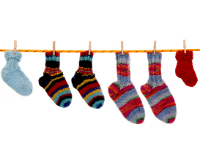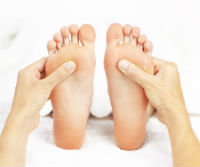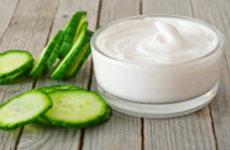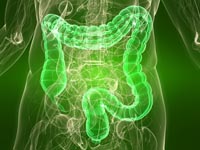In preparation for flu season, conventional methods of dealing with the virus are beginning to hit the market. The most notable and one of the most controversial is the flu vaccine. Every year, a new vaccine is formulated with 3 strains of flu viruses that researchers have determined are to be the most prevalent. The Center for Disease Control recommends that everyone over the age of 6 receive a flu shot, but especially the elderly, those with chronic illnesses, and those with a weakened immune system.
But is the flu vaccine really right for your family? The CDC says the vaccine doesn't work in every case. In fact, there are two factors that determine its effectiveness. First, a person's state of health is a factor. Those with healthy immune systems will respond better to the vaccine. Second, its effectiveness is also determined by what strains of the virus are included in the formulation. The flu vaccine targets only the three most prevalent strains of flu but there are actually many other types of viruses that circulate during flu season that can bring on similar symptoms. So depending on how healthy you are and what viruses circulate in your area, the CDC states, "it's possible that no benefit from flu vaccination may be observed." In addition, very few studies have been conducted of the safety of flu vaccines as new formulas are developed. In fact, there are disturbing reports of adverse effects of flu vaccines, especially for pregnant women. Also, very few longitudinal studies been conducted to determine the long-term effect of vaccine use. Essentially, the fact is that our public health policy has embraced a form of flu prevention that they cannot guarantee is safe or effective.
That's why Naturopathic Medicine focuses on strengthening the body's immune system as a standard flu prevention method. Naturopathic Doctors know that boosting a person's health is the single most effective way to prevent disease in the body. Not only is it safe to enhance the body's immunity, but it is an effective method for preventing infection from ALL the viruses that circulate during flu season, not just the three most common. That's why, unlike the advocates of flu vaccines, Naturopathic Doctors can guarantee that immune-boosting preventive medicine is both safe and effective for every member of your family. There are also no negative side effects, and the positive side effects include having more energy and feeling better in general.
Whatever you decide to do for your family, everyone can benefit from the following tips to fight the flu naturally:
• Basic Hygiene. Wash hands frequently, especially after visiting public places. Cover your mouth when coughing and sneezing.
• Get More Sleep. Not getting proper rest can put unnecessary stress on the body and lower immunity. Get at least 8 hours of high-quality sleep each night, and rest more when you feel under the weather. Sleep is when your body repairs itself.
• Eat a Whole Food Diet. Minimize refined sugar and flour in diet; avoid processed foods, eat colorful vegetables, proteins (fish & fowl, starchy legumes, nuts & seeds), fruits, whole grains.
• Increase Vitamin C. Eat foods such as kiwi, grapes, strawberries, and oranges to give your body an antioxidant and immune boost. You may also want to add supplemental vitamin C to your regimen. Speak with Dr. Bossio about the appropriate dose for you as this can range from 250mg to 6000mg per day.
• Increase Vitamin A. Vitamin A helps maintain the health and integrity of the mucous membranes, so foods such as carrots, sweet potatoes, spinach and kale can also help stave off the flu.
• Increase Vitamin E. It can help boost immunity and enables T-cells to fight infection. E rich foods include almonds, sunflower seeds, butter and egg yolks.
• Increase Zinc. Zinc is extremely important during cold and flu season because many immune cells require zinc for optimal function. To increase zinc in your diet, try eating more Crimini mushrooms, shiitake mushrooms, and spinach. Other good sources include asparagus, chard, scallops, lamb, beef, maple syrup, shrimp, green peas, yogurt, oats, pumpkin seeds, sesame seeds, turkey, miso, and spelt. You may also consider supplementing with Zinc lozenges.
• Supplement Vitamin D. Japanese researchers have shown that school aged children taking 1200 IU of Vitamin D per day had a 42% lower risk of contracting the flu than children taking a placebo. Vitamin D has increasingly been shown to be one of the most effective ways to prevent illness. The appropriate dose of vitamin D should be determined based on your blood level. If this has not already been evaluated speak with Dr. Bossio about doing so.
• Probiotics. Probiotics are best known for their role in digestive health, but science shows they are powerful components of immune system health as well. Since 60% of our immune cells are located in the digestive tract it makes sense that keeping those cells functioning well is important for staying healthy. Adding a probiotic to your daily supplement regimen can help optimize your health this fall and winter season. Speak with Dr. Bossio to determine which probiotic is right for you.
• Drink Herbal Tea. Herbal teas such as red clover, echinacea, elderberry, lemon and honey, or other commercially available cold/flu formulas can help fortify the body's immune system. Also, green tea is high in antioxidants and can help strengthen T-cells (the body's primary defense against infections).
• Homeopathic Flu Vaccine. A homeopathic flu vaccine is similar to conventional vaccines, only without the harmful additives, preservatives, and side effects. Homeopathic flu (Influenzinum) uses infinitesimal doses of flu strains to stimulate your body's vital force to offer protection from invading pathogens.
Resources
Photo credit. Free Digital Photos.
http://www.freedigitalphotos.net/images/stamp-toxic-photo-p261778.
Centers for Disease Control and Prevention. 2013. Vaccine Effectiveness - How Well Does the Flu Vaccine Work?. Retrieved 21 August 2013 from http://www.cdc.gov/flu/about/qa/vaccineeffect.htm
Centers for Disease Control and Prevention. 2013. Who Should Get Vaccinated Against Influenza Retrieved 21 August 2013 from http://www.cdc.gov/flu/protect/whoshouldvax.htm
Alan Casseis. 2012. Eminence vs. Evidence. http://www.cochrane.org/news/blog/eminence-vs-evidence
Dearing, S. 2010. Medical reviews conclude influenza immunizations ineffective. Digital Journal. Retrieved 25 October 2010 from www.digitaljournal.com/article/288946
England, C. 2010. Thousands of USA pregnant women miscarry after the H1N1 vaccine. American Chronicle. Retrieved 20 October 2010 from www.americanchronicle/articles/view/188385
Urashima, M., Segawa, T., Okazaki, M., Kurihara, M., Wada, Y., and Ida, H. 2010. Randomized trial of vitamin D supplementation to prevent seasonal influenza in schoolchildren. American Journal of Clinical Nutrition. 91(5) 1255-60.




















